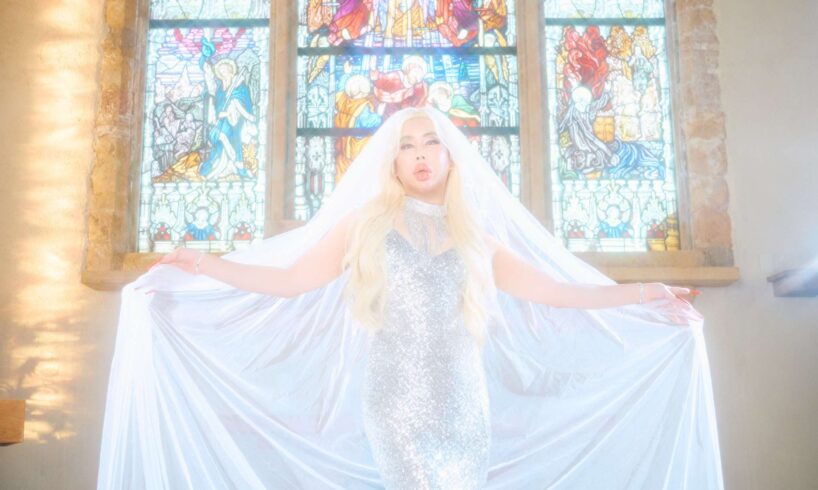
Who is アレン様 (Allen-sama)?
From Allen-sama’s first book (©KADOKAWA / Photo by Yoshinobu Bito via PR Times)
Most likely, you don’t know much about Allen… or Allen-sama (with an honorific suffix). And that’s fair. Not much comes up when you Google their name in English.
However, if you want to understand Japanese meme culture, this diva is absolutely worth knowing. In fact, it’s only a matter of time before Allen-sama joins the larger Floptropica universe run by chronically online netizens of the Anglosphere.
Metropolis isn’t Know Your Meme: Japan Edition, but here’s our attempt. The world of Japanese memes is vast, chaotic and deeply layered, just like the English-speaking internet’s own surreal, post-ironic meme culture. But unless you understand the language and cultural cues, it can feel impenetrable. Explaining its humor perfectly is an impossible task, especially for anything absurdist or surrealist.
Still, Allen-sama’s appeal is surprisingly easy to grasp when you frame it through the lens of “FlopTok” culture. A messy, chaotic, hyper-sexual, queer and hyper-feminine persona that receives a mix of genuine admiration and ironic obsession. You could say that Allen-sama is in a similar realm: plastic surgery-obsessed, sexually unhinged, always hyperbolic and occasionally problematic, but always charismatic.
In this piece, we break down who Allen-sama is, how they became a social phenomenon, the cult-like fandom known as the “Kuriman” and the spread of Allen-sama language online. The meme-ability of Allen-sama aligns closely with “FlopTok” culture, and we personally believe this diva deserves a big, fat spot in Floptropica.
Who Is This Diva? Allen-sama’s Journey
Allen-sama first appeared on Japanese television around 2014, introduced as “Japan’s No.1 Plastic Surgery Boy” (日本一の整形男子, nihon ichi no seikei danshi). At the time, they were known simply as “Allen” and gained attention for claiming to have spent over ¥100 million (around $1 million USD) on cosmetic procedures. This was during an era when Japanese media, much like Channel 4 in the UK, often featured late-night spectacles like extreme beauty obsessions and niche addictions.
Allen, in this era, was relatively reserved, soft-spoken and more “boyish” in appearance, even while making bold claims, such as having numerous international patrons who funded their transformation.
For a while, Allen faded from the spotlight (I guess you could say “flopped,” for about 6 years). But their return in 2020, as the host of a YouTube channel about plastic surgery, changed everything. As audiences fell for Allen’s larger-than-life, chaotic, witty, and campy charm, the educational platform evolved into something entirely different. Around this time, netizens collectively began referring to them as Allen-sama, a suffix that conveys the diva status, or even ironic worship*. Soon, fans demanded more Allen-sama and less of the medical specialists. By 2023, Allen-sama had launched their own channel and was named runner-up in the Gen-Z Trend Influencer Grand Prix 2024’s influencer category. As their popularity resurged, Allen-sama began appearing again on major TV shows, occasionally even serving as a commentator on news programs.
These days, Allen-sama is introduced with titles like “Living Illusion” (生きる幻), “Walking Power Spot” (歩くパワースポット), “High Priestess of the Reiwa Era” (令和の大教祖様), and even “Bigwig Madam Tarento” (大御所マダムタレント).
The original “plastic surgery boy” label has faded, not just because of their evolution in gender presentation, but because Allen-sama is no longer known solely for the number of cosmetic procedures they’ve undergone. They’re simply famous for being famous.
From Allen-sama’s official Instagram
*-sama (様) is a Japanese honorific suffix denoting respect, typically reserved for customers, gods, or members of the imperial family. However, it can also be used humorously in pop culture. One of the earliest examples was actress Erika Sawajiri, who, despite her innocent image, was quickly “canceled” for rude behavior and later for drug-related scandals. The media began attaching “-sama” to mock her “prima donna” persona. Still, she gained a cult following, especially among queer audiences, who embraced her as a chaotic diva. Since then, the suffix has come to signify a blend of notoriety, fabulosity and queer-coded reverence.
Floptropica’s Missing Japanese Icon: Allen-sama
Allen-sama fits seamlessly into what English-speaking internet users know as “flop culture.”
The term “flop” originally referred to commercial failure (i.e., flop era) but has since evolved into a form of ironic, often queer-coded praise.
As Know Your Meme explains, FlopTok and Floptropica refer to a genre of humor that uses “predominantly feminine and LGBTQ+ meme references and characters to paint a universe called Floptropica located on the imagined Floptropica Island, where the characters and memes exist.”
The aesthetic is messy, low-quality and moldy on purpose (like the distorted, grainy textures of hyperpop music). Floptropica often revolves around “flop icons” and (externally created) scenarios about them. It’s often said to operate like dojin (fan fiction) culture.
The icons include Nicki Minaj, Doja Cat, Ariana Grande and many K-pop idols. The FlopTok also celebrates absurd self-confidence, vulgarity and figures that aren’t usually appreciated in “respectable” spaces. Think of artists like CupcakKe, often credited, albeit unintentionally, as one of the pillars of this culture.
“Randomness” is another defining element. Some influencers or social media figures are randomly absorbed into the culture, like Deborah Ali-Williams, the president and funeral director at All Peoples’ Funeral, as well as surreal, fictional personas like Jiafei, who originated from a photo of a woman used by spam accounts advertising Chinese products.
The continued commercial success of these artists demonstrates how “flop” itself has evolved beyond its original meaning of commercial failure (“flop era”) to something more like a “mode of aestheticism” to borrow Susan Sontag’s phrasing on camp aesthetics.
Allen-sama fits this perfectly. Their video clips, reaction screenshots and meme-worthy moments have become a language of their own, used to express a wide range of emotions and contexts. Allen isn’t just liked; they’re “stanned.” The appeal isn’t rooted in pure admiration for their art, but in the iconicness we project onto them as a figure.
In short, Allen-sama is leading the Japanese gays and girls’ meme culture, playing the same role that FlopTok icons do in the West.
From Allen-sama’s official YouTube channel
*We can’t possibly explain the full depth of Floptropica in this article, but if you’re curious, check out this YouTube video or browse the Floptropica fandom wiki for more.
Who Are “Kuriman”?
Allen-sama’s fans are collectively known as the “Kuriman” (クリマン). The term itself is a cheeky portmanteau of kuri(short for kuritorisu/clitoris) and man (short for manko, a colloquial term for vagina). Online, fans often use the emoji combo “🌰🈵” because kuri means chestnut in Japanese, and the second emoji features the kanji man, meaning “full” or “occupied,” as in a parking lot or restaurant booking.
Non-Kuriman are referred to as “NP,” short for “Normal People,” unenlightened civilians. The NP lifestyle leads to, in their words, “路確” (ro-kaku), an abbreviation of “路上生活確定” (rojo seikatsu kakutei), literally “street-dwelling confirmed.”
The only path to salvation? Become Kuriman and accept the mantra of “全ア” (zen-a/All-A[llen]), short for “全部アレン様が正しいでございます” (All truth lies with Allen-sama). The Kuriman community is predominantly female, though male fans exist; often gay men or boyfriends of Kuriman who were dragged into the cult. These men are called “Menkuri (メンクリ).”
Allen-sama and the Kuriman fandom have grown into a social phenomenon. Interestingly, the Kuriman culture developed online without Allen-sama’s intention or involvement; it was collective and natural, like most memes. But as the fandom grew, Allen-sama fully embraced the “cult leader status.” They’ve since hosted IRL fan events, launched a skincare line, produced colored contact lenses, published best-selling books and released official LINE stickers. There have even been Allen-led fan bus tours to places like Izu, where you travel with Allen-sama as your guide and host. It’s a whole new universe.
LINE stickers (via LINE Sticker Shop ©ALLEN)
The “Kurimanese” Language
From all the new vocab like ro-kaku and NP, you might have guessed already… but Kurimans have their own way to communicate. It is called “クリマン語”(Kuriman-go/Kurimanese) or “アレン様構文” (Alen-sama kobun/Allen-sama sentence structure).
Trying to explain the full system is nearly impossible in a single article; Kurimanese is a dialect of its own. Since it’s based in Japanese, many of its quirks are deeply rooted in the language’s structure, such as sentence-ending particles. If you’re curious, the best way to explore is to do some online fieldwork.
For starters, there are fan-made websites that convert regular Japanese into Kurimanese. And multiple fan blogs attempt to explain the Kurimanese grammar systems.
Let’s look at just a few examples (this is barely the tip of the iceberg):
・Sentence endings are everything
Some were coined by Allen-sama, others mimic hyper-feminine speech or heightened posh speech. End sentences with “~ざます” (-zamasu) or “~だわよ” (-dawayo). Some sentence-ending particles are actually just from Allen-sama’s hometown dialect of Tosa-ben from Kochi Prefecture. (Though this does conflict with the “fact” that Allen-sama is supposedly from Dubai, UAE)
・Pop culture puns
For example, the grammatical particle “~から” (-kara, meaning “because”) is replaced with “KARA” (as in the beloved K-pop group), and users often add a South Korean flag emoji to drive the joke home.
・Typography
Kurimanese often uses fancy fonts, like cursive, fraktur or pseudo-Cyrillic, and lowercase hiragana or katakana. These echo gyaru subculture styles, much like how English speakers use Zalgo text or vaporwave fonts for aesthetic effect.
・Emoji usage
Emojis are central to the style, especially those that suggest bimbo glamour, luxury or flamboyance. Think 🌹💎✨💄.
・Invented vocabulary
A Kurimanese way to say “lol” is “苔むす” (komemusu, literally “to grow moss”)—likely an evolution from traditional internet slang like “笑”(warai), “w” or “草”(kusa, meaning “grass” = laughter).
See? It’s a lot.
In fact, even linguists have taken note. Wes Robertson, a sociolinguist at Macquarie University who regularly covers emerging Japanese slang on his blog, included one Kurimanese phenomenon in a 2023 update: the replacement of “けど” (kedo, “but”) with “㌔” (kiro, like kilogram).
That he noticed just this one detail speaks volumes: some parts of Kurimanese are already making their way into broader Japanese slang, even among people who aren’t Kuriman. Just like how LGBTQ+ and African American Vernacular English shape mainstream English slang, this shows how fringe communities online influence wider cultural language trends.
Example of “Kurimanese” from Allen-sama’s official X
Allen-sama and Celebrity Culture
There is a trend among young women of using a photo of Allen-sama as their phone wallpaper. The gold, sparkly one, in particular, is said to bring good luck. However, a rumor warns that if you change the wallpaper back to another image, you’ll be punished and experience “living hell.” In this sense, Allen-sama functions almost like an ambivalent deity in some animistic religions.
What makes Allen-sama’s status comparable to that of a “flop” icon also lies in the ambivalence, too. It’s the fine line between celebration and irony. Allen-sama is, of course, entertaining and iconic, but that doesn’t mean everyone agrees with their opinions or actions. Their free-spirited behavior, extravagant fashion and loud personality give many people the confidence to not take things too seriously. Meanwhile, Allen-sama’s diva persona often involves being a public nuisance on the street or acting like a “Karen” toward staff members.
Additionally, as Allen-sama has become a kind of commentator on television programs, they have occasionally expressed views such as opposing the admission of transgender women to women’s schools or claiming that LGBTQ+ pride parades are what make LGBTQ+ individuals seem “abnormal,” because they “stand out.” (This reflects a common argument rooted in false equivalence and a disregard for existing inequality.)
Many younger viewers have disagreed with these statements. Yet this, too, is part of what defines a meme icon. The affection toward the persona remains intact precisely because the appreciation is already, to some extent, ironic. Many of the young people who use Allen-sama memes or Kurimanese in their conversations don’t necessarily agree with or want to be like Allen-sama. The engagement is more ambiguous and layered, which is exactly what makes it so fascinating. I believe it reflects the way Gen-Zs interact with celebrities, perhaps healthier, which prevents the “never meet your hero” dilemma.
Allen-sama is unique, yet their popularity reflects a broader phenomenon within the online cultures shaped by contemporary youth. Although discussions often focus on the peculiarities of Japanese pop culture, Allen-sama’s universe points to something more universal, if you take a closer look.
(Via PR Times, from the Hotel Lovers colored contact lens collaboration release)
From Allen-sama’s first book (©KADOKAWA / Photo by Yoshinobu Bito via PR Times)





